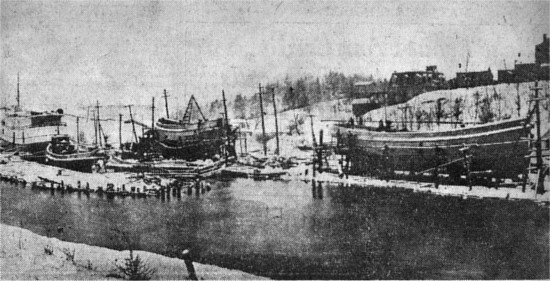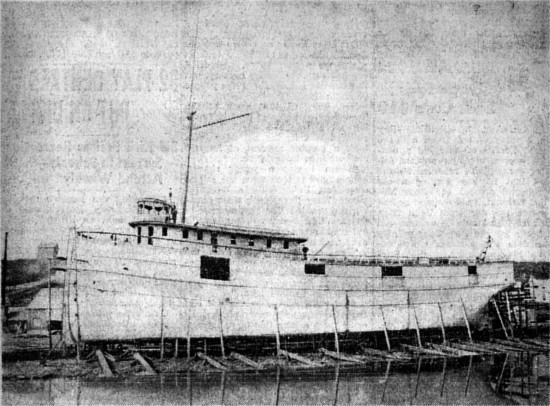Mighty Maltese of Shipman's Corner
Toronto Telegram, 16 August 1947
Schooner Days DCCCVIII (808)
By C.H.J. Snider

For six and seventy years Louis Shickluna breathed the air of ships and ship building. He was born in 1808, so near the Royal Dockyard a Malta that the sound of caulkers' mallets was his first lullaby. He died near his own shipyard at St. Catharines, Ont., in 1884, and the homey sound of shipwright's tools at work was his requiem.
He was a poor boy, orphaned at a very early age, unlettered, untutored. The Royal Dockyard was his world, and constituted all that he knew of life in childhood, adolescence and early youth. Before he was twenty-one he was a full fledged shipwright and noted for his superb skill with the tools of his craft.
Then other worlds beckoned.
'Twas a recognized mark of great skill for a ship carpenter to hold a billet of wood "under his toe" and hew a wedge with a lip-adze, using head-high strokes. A ship carpenter's lip adze is the most dangerous of edged tools. The width of its bitt between the razor-sharp lips is not much greater than the width of a man's shoe sole. Louis Shickluna, could and frequently did use a lip adze for hewing his wedges under his toe, and his hewing was done with full-arm swings. One who assays to hew wedges under his toe with a lip adze must needs strike absolutely true or he will surely shear off his toes or the sole of his foot.
Shickluna could make a perfect job of hewing out the finely curved and twisted rabbets or curved grooves of a vessel's forefoot without using a shaping tool; or without guiding marks he could adze off a caulking seam in perfect bevel for the length of a fifty-foot plank and leave no tool marks.
From Malta 120 years ago
Other worlds beckoned. In a manner that he never explained. The young Maltese found passage to New York a century and more ago. As shipbuilding was the one craft that he knew well, he borrowed a pair of hip boots from a friendly carpenter to whom he introduced himself and proceeded to explore the adjoining yard. A shipwright was attempting to fit a new sill to the sternpost of an old vessel that had been cut down for timber barge service. It was a complicated and tricky piece to fit to the ship's stern rise and the curve of her counter. The carpenter failed twice to make even a near fit.
Then in his quaint Maltese-English young Shickluna asked him if he needed help. "I sure do" the baffled craftsman replied. "Do you know anything about it?" "But yiss sir, very much," the Malta boy replied. "You lend me so a chalk and a rule?" The chalk and rule were immediately produced. Shickluna measured; and chalked queer characters on the sides of his borrowed hip boots as he had done many, many times at the Royal Dockyard, while the carpenter stood puzzled.
"Yiss sir, now I make," the boy announced finally. And with borrowed tools he went to work on the curved sill, referring constantly to the chalked hieroglyphics on his boots.
"Aintcha gonna try it to see how she fits?" the carpenter asked.
"Oh, yiss sir. I'll try 'er and she'll fit when I make," Shickluna assured him. And when he made it, the sill fitted perfectly.
The boy was offered a job in the New York yard, but refused it. He was bound for Canada.
Worked at Oakville

Capt. Van Cleve's assertion that Louis Shickluna built the R. H. Boughton, which was launched in Youngstown, in 1829, is not inconsistent with other statements that Shickluna worked in Quebec shipyards when he was 23, at the building of the Royal William, launched in 1831, the first Canadian steamer to cross the Atlantic, and at Oakville, in 1832, on the 350-ton steamer Constitution, later known as the Transit. After that he worked at dock building and vessel building at Niagara and Youngstown; all part of the travelling shipwright's experience. He established his St. Catharines yard in 1836 and kept it going for forty-eight years. His first known vessel from the St. Catharines yard was the 2-masted schooner Lady Bagot, of about 100 tons. His last was the composite steel and wood propeller Sir Leonard Tilley, of ten times that burthen.
The Shickluna shipyard was close to and above lock 3 of the second Welland canal and only locks One and Two could accommodate craft of greater dimensions than accepted "canal size." The Tilley's plans called for a vessel of considerably more than canal size; so she had to be built on the canal bank, below Lock 3 so that she might be taken down to Lake Ontario. He died before the Tilley was completed. His foreman, Patrick Dixon, finished and launched the ship. The Dixon interests took over the St. Catharines shipyard and operated it for ten years or more after Shickluna's death.
